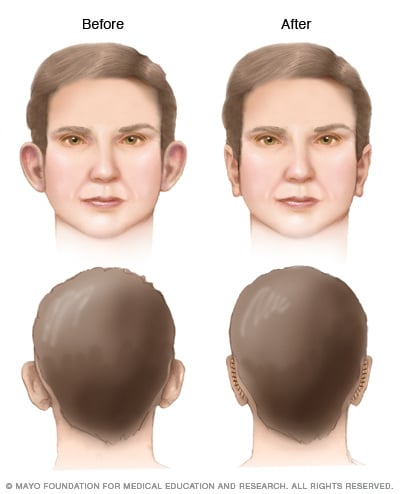Otoplasty
Overview

Otoplasty is a surgery to change the shape, position or size of the ears.
This surgery may be used in a number of situations. For example, some people choose to have otoplasty because they are bothered by how far their ears stick out. Others might get this surgery if one or both ears have changed shape due to an injury. Otoplasty also may be used if the ears are a different shape because of a birth defect.
Otoplasty can be done any time after the ears have reached their full size. In general, children can get this surgery as early as 4 to 6 years old. Adults also can get otoplasty.
If a baby is born with prominent ears and certain other ear-shape issues, a different treatment may be an option. It's called splinting, and it doesn't involve surgery. Devices called splints are placed on the baby's outer ear. The splints are adjusted each week for about 4 to 6 weeks. For best results, splinting must be done during the first few days of life. This is when the ear is soft and can be molded. Splinting is less effective when it's done after the first few weeks of life.
Why it's done
You might think about getting otoplasty if:
- Your ear or ears stick out too far from your head.
- Your ears are large compared with your head.
- You're not happy with the results from a past ear surgery.
Often, otoplasty is done on both ears to help give the ears a balanced look. This concept of balance is called symmetry.
Otoplasty doesn't change where on your head the ears are located. It also doesn't change your ability to hear.
Risks
As with any surgery, otoplasty has risks. These risks include bleeding, blood clots and infection. It's also possible to have a reaction to medicines called anesthetics that prevent pain during surgery.
Other risks of otoplasty include:
- Scarring. Scars from the incisions won't go away after otoplasty. But they'll likely be hidden behind your ears or within the creases of your ears.
- Ears that don't look balanced in placement. This is called asymmetry. It could happen due to changes during the healing process. Also, otoplasty might not fix asymmetry that was present before surgery.
- Changes in feeling. Changing the position of your ears can affect how the skin feels in those areas. This effect often goes away, but rarely it is lasting.
- Ears look "pinned back" after surgery. This is known as an overcorrection.
How you prepare
You'll talk to a plastic surgeon about otoplasty. During your first visit, your plastic surgeon likely will:
- Review your medical history. Be prepared to answer questions about current and past medical conditions, especially any ear infections. You also may be asked about medicines you take or have taken recently. Tell your surgery team about any surgeries you've had in the past.
- Do a physical exam. Your surgeon checks your ears, including their placement, size, shape and symmetry. This helps determine your treatment options. Pictures of your ears may be taken for your medical record.
- Discuss your goals. You likely will be asked why you want otoplasty and what results you expect.
- Talk with you about the risks of surgery. Make sure you understand the risks of otoplasty before you decide to move forward with surgery.
If you and your plastic surgeon decide that otoplasty is right for you, you then take steps to prepare for surgery.
Medicines and herbs
You'll likely be told not to take aspirin, anti-inflammatory medicines and herbal supplements. These can make you bleed more easily.
Smoking
If you smoke, stop smoking before surgery and during recovery. Smoking lowers blood flow in the skin and can slow the healing process.
Other planning
You'll need to make plans for someone to drive you home after surgery. A friend or loved one should stay with you for the first night of your recovery too.
What you can expect
Before
Otoplasty can be done in a hospital or in a medical center where surgery can be performed.
You'll likely be given medicines called general anesthetics that put you in a sleep-like state and prevent pain. Or you might be given medicines called local anesthetics that prevent pain in part of the body. Local anesthetics are given along with medicines called sedatives that relax you.
During
Otoplasty techniques vary. The technique your plastic surgeon chooses determines where the incisions are made.
Your surgeon might make incisions on the backs of your ears or within the inner creases of your ears. Surgeons often choose these areas to help keep otoplasty scars hidden.
After making incisions, your surgeon might remove extra tissue including cartilage and skin. Then the cartilage is folded into the proper position and secured with stitches inside the ear. More stitches are used to close the incisions.
The surgery typically takes about 1 to 2 hours.
After
After otoplasty, your surgery team covers your ears in bandages or dressings for protection and support.
You'll likely feel some discomfort and itching. Take pain medicine as recommended by your surgery team. If you take pain medicine and your discomfort gets worse, call a member of your surgery team right away.
To keep pressure off your ears, don't sleep on your side. Also, do not rub the incisions or place lots of force on them. It helps to wear button-down shirts or shirts with loose-fitting collars.
A few days after otoplasty, your surgery team removes your bandages. Your ears likely will be swollen. You may need to wear a loose headband that covers your ears at night for a few weeks. This helps keep you from pulling your ears forward when rolling over in bed.
Talk to a member of your surgery team about when or if your stitches will be removed. Some stitches dissolve on their own. Others must be removed in the surgeon's office in the weeks after surgery.
Ask your surgery team when it's OK to go back to your usual activities, such as bathing and physical activity.
Results
When your bandages are removed, you'll see a change in how your ears look. These changes typically are long lasting.
If you're not happy with your results, you can ask your surgeon if a second surgery would help. This is known as a revision surgery.



